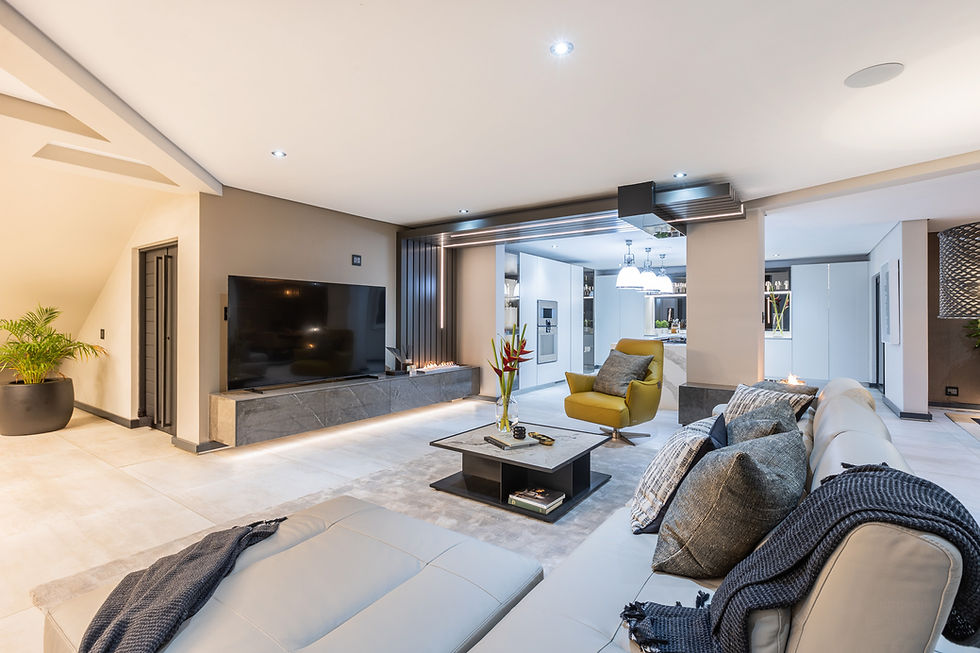Designing with Symmetry and Asymmetry
- Theo Arewa-Bothma

- Jun 23
- 7 min read
Mastering Symmetry and Asymmetry in Interior Design: Create Balanced, Dynamic Luxury Spaces with Intentional Style
Step into a well-considered room, and you’ll feel it before you see it. There’s a rhythm, almost a breath, that carries you through the space. A quiet pull toward a sculptural chaise, a subtle echo between twin sconces, a bold art piece that stands slightly off-centre but commands attention with the poise of a lead dancer stepping out of formation. This is the language of symmetry and asymmetry, two visual dialects that shape the emotional cadence of a room.
At Studio 8687, we don’t just furnish spaces; we choreograph them. For our clientele, whose lives are punctuated by both tradition and innovation, homes must reflect a similar duality. Symmetry offers a serene, grounded elegance. Asymmetry injects vitality, tension, and a curated sense of the unexpected. Knowing when to use each, and how to combine them artfully, is not just a design decision. It’s an expression of identity.
In this article, we’ll explore how balance and imbalance can create focus, energy, and atmosphere in a room. More importantly, we’ll discuss how these concepts can be applied with subtlety and sophistication, crafting spaces that are as emotionally intelligent as they are visually arresting.
The Power of Symmetry, Calm, Confidence, and Classical Precision
Symmetry is the quiet language of order. It brings calm to a space the way a steady rhythm brings calm to a heartbeat. At its best, symmetry feels effortless: two sculptural chairs flanking a fireplace, a pair of pendant lights suspended at equal height, or a set of tall windows dressed in matching drapery. But beneath the visual ease lies a precise architectural logic. For Studio 8687, symmetry is more than a layout, it’s a mindset. It lends itself naturally to spaces that call for serenity and formality: grand entrances, formal sitting rooms, master suites. In these environments, symmetry speaks with confidence and clarity, providing a spatial backbone that makes every detail feel intentional.
There are two primary expressions of symmetry in interior design. The most familiar is bilateral symmetry, where one half of the room mirrors the other. This might take the form of matching vanities in a luxurious ensuite, or a living room where identical side tables bookend a low-slung sofa. This form creates a sense of harmony that’s both visual and emotional; it tells the mind that everything is in its place. The second, less commonly used form is radial symmetry, where design elements radiate outward from a central point. Think of a round dining table anchored by a sculptural chandelier above and a circular rug below. It’s a powerful way to introduce a sense of occasion, making the centre of the space feel like the heart of the experience.
The key to executing symmetry well lies in the art of balance, not just in form, but in materiality, colour, and proportion. A symmetrical room should never feel sterile or overly staged. Rather, it should unfold gently, like a well-composed sonata.
Material repetition plays a critical role in reinforcing this emotional harmony. Mirrored finishes such as book-matched marble or a pair of alabaster lamps can subtly reflect one another without feeling literal. Similarly, maintaining tonal consistency across textiles and finishes helps unify the space. Scale and visual weight must also be carefully considered; every piece in a symmetrical arrangement should carry its own authority without overpowering its twin. It’s not about duplicating objects; it’s about orchestrating visual harmony.
Symmetry is ideal for individuals who value clarity, control, and calm, those who see their home as a haven of stillness amid the chaos of modern life. But even within the bounds of balance, there’s room for individuality. A symmetrical space can still tell a unique story. The real question is: where in your home would you most appreciate a sense of groundedness? And how might the quiet strength of symmetry enhance the way you experience that space?
The Allure of Asymmetry, Movement, Personality, and the Art of the Unexpected
Where symmetry offers peace, asymmetry offers pulse, a curated tension that brings rooms to life. It is the visual equivalent of jazz: unpredictable, nuanced, and full of energy. In a high-end residential space, asymmetry isn’t about randomness; it’s about deliberate contrast and the artful disruption of expectation. When used with intention, it becomes a powerful storytelling tool, an expression of individuality, of design with edge and attitude.
Asymmetry thrives where life is dynamic: in open-plan living areas where furniture zones shift organically, in art galleries where a single piece steals the show, or in dressing rooms where lighting, mirrors, and sculpture come together in carefully unbalanced harmony. The beauty of asymmetry lies in its ability to surprise. It draws the eye across the space, compelling it to pause, consider, and move again. It creates rhythm, not with repetition, but with variation.
Designing with asymmetry requires a refined understanding of visual weight and balance. One large object can be offset by several smaller ones. A bold material can be tempered with muted tones elsewhere. It’s a spatial dialogue that works because every piece is in conversation with its counterparts, even when they’re not identical. Lighting becomes especially powerful here; varying heights of pendants or layered floor lamps can create vertical interest and depth. Asymmetry also thrives on material contrast: the interplay of rough and smooth, matte and polished, angular and curved.
Texture and tone are essential to keeping asymmetric compositions from feeling disjointed. A curved travertine bench placed off-centre can still feel purposeful when its colour ties back to nearby drapery or wall cladding. Likewise, the juxtaposition of a handmade ceramic bowl atop a slick lacquered console introduces narrative tension: old meets new, raw meets refined. For clients who travel extensively or collect globally, asymmetry is often the most authentic way to reflect their lifestyle; layered, unpredictable, and deeply personal.
This approach especially resonates with clients who see their homes as evolving expressions rather than fixed monuments. Asymmetry gives permission for asymmetry in life; for imperfection, change, and creativity. The key is in the curation. Done well, it’s a quiet form of rebellion that never sacrifices elegance.
So, where might your home benefit from asymmetrical energy? Perhaps it’s the art wall in your hallway, where one large piece steals focus from a cluster of smaller frames. Or the corner of your lounge that could house a single statement chair, unexpected, yet magnetic. Asymmetry invites you to think beyond the predictable, and in doing so, it infuses your space with energy that feels uniquely yours.
Blending Symmetry and Asymmetry, A Dialogue Between Control and Creativity
The true magic happens when symmetry and asymmetry coexist, when stillness meets movement, and order is interrupted just enough to spark intrigue. For sophisticated interiors, this balance is the ultimate expression of curated design. It allows a space to feel grounded and structured while still being full of character. In many ways, this is the sweet spot of luxury: where refinement embraces risk.
At Studio 8687, we often begin a design with a symmetrical architectural framework, a centred fireplace, a row of evenly spaced columns, or perfectly aligned floor-to-ceiling windows. These elements act as the room’s visual anchor. Once that core stability is established, we introduce asymmetry through furnishings, accessories, or lighting to add dynamism. It’s not about breaking the rules; it’s about knowing which rules to bend and where. A room designed in this way feels like a well-tailored suit with an unexpected silk lining: timeless on the outside, surprising within.
Blending these opposing forces requires precision. Too much asymmetry and the room can feel chaotic; too much symmetry and it risks becoming static. The key is to let one dominate subtly while the other disrupts just enough to elevate the composition. For example, a formal dining room may feature a symmetrical arrangement of furniture, but asymmetrical artwork or lighting can inject personality. In contrast, an informal entertainment space might lean heavily on asymmetrical elements but be grounded by a symmetrical rug or shelving layout.
Material choice plays a vital role in this fusion. Symmetry might be reinforced through repetition of materials, twin velvet armchairs in a deep aubergine, or a pair of brass wall sconces, while asymmetry might be introduced through a singular statement piece: a hand-carved African stool, a blown-glass vase, or a vintage Italian lamp. These insertions shift the visual rhythm without unsettling the core harmony of the space.
This technique also helps guide emotional pacing through the home. Transitional areas; like corridors, entryways, and mezzanines, benefit from this balanced tension. A symmetrical hallway lined with evenly spaced doors feels formal and grounded, while a single unexpected light fixture or art piece along the way creates a moment of pause, a visual whisper that says, “There’s more to see.”
For our clients, individuals whose lives are often defined by both structure and spontaneity, this nuanced blend resonates deeply. It mirrors the way they navigate the world: deliberate, discerning, yet always open to inspiration. The question becomes: where in your home do you want certainty, and where are you willing to embrace surprise?
Ultimately, the interplay of symmetry and asymmetry isn’t just about spatial arrangement. It’s about shaping emotional experience, inviting calm where it’s needed and movement where it’s desired. The result is a home that doesn’t just look luxurious; it feels alive.
In the world of high-end interior design, the dance between symmetry and asymmetry defines the very soul of a space. Symmetry offers us a refuge, a sanctuary of calm, clarity, and timeless elegance. Asymmetry challenges and excites, weaving movement and personality into the fabric of our homes. But the true mastery lies in their union: the thoughtful blending of balance and tension that creates environments both grounded and alive.
For those who seek more than just beautiful interiors, who desire spaces that resonate emotionally and narrate their unique story, understanding this dialogue is essential. It is through the interplay of order and surprise that your home transforms from a backdrop into a living, breathing extension of yourself.
We invite you to reflect: where do you crave serenity, and where do you yearn for dynamic energy? How might the principles of symmetry and asymmetry help you compose your next interior masterpiece?













Comments